AMD Announces ATI Mobility Radeon 5000 Series
by Jarred Walton on January 7, 2010 12:01 AM EST- Posted in
- Laptops
Performance Preview
Since we don't have hardware, we are left with the charts that ATI provided. Obviously, you need to take these benchmark results with a huge grain of salt, but for now it's all we have to go on. ATI provided results comparing performance of their new and old Performance (5650 vs. 4650) and Enthusiast (5870 vs. 4870) solutions, an additional chart looking at WUXGA single vs. CrossFire performance, and two more charts comparing performance of high-end and midrange ATI vs. NVIDIA. Here's what we have to look forward to, based on their testing.
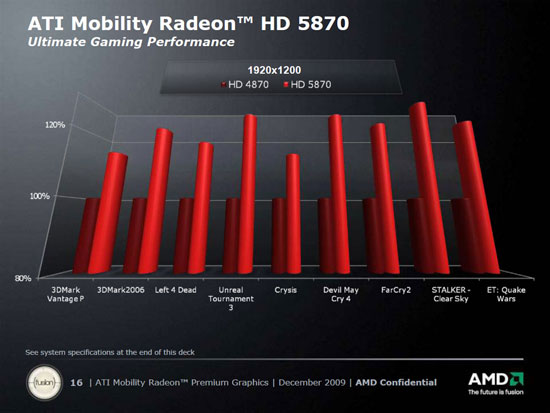
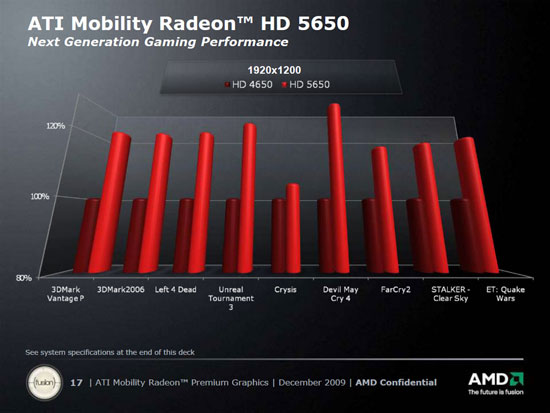
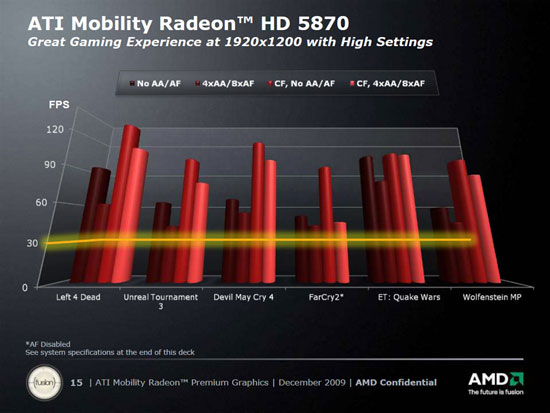
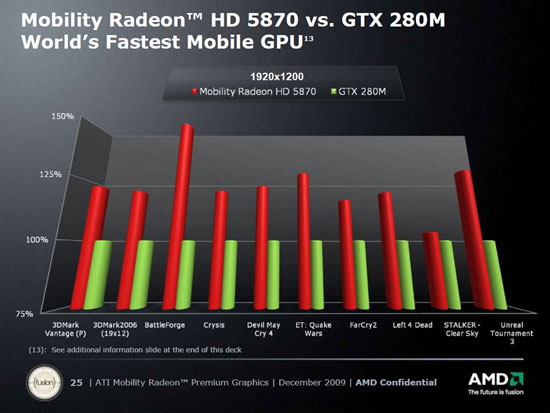
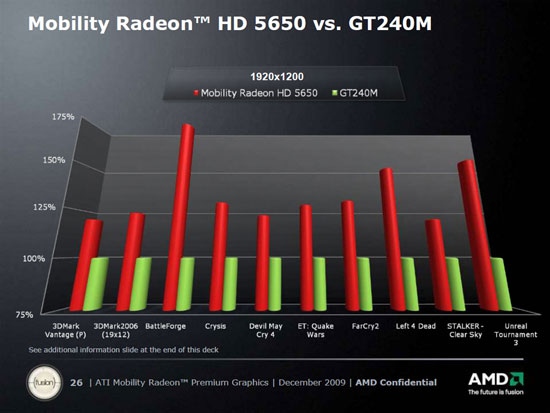
The performance is about what we would expect based on the specifications. Other than adding DX11 support, there's nothing truly revolutionary going on. The latest 5870 part has a higher core clock and more memory bandwidth - 27% more processing power and 11% more bandwidth compared to the standard HD 4870, to be exact. The average performance improvement appears to be 20~25%, which is right in line with those figures. Crysis appears to hit some memory bandwidth constraints, which is why the performance increase isn't as high as in other titles (see the 5650 slide for a better example of this).
On the midrange ("Performance") parts, the waters are a little murky. The highest clocked 5600 part (5750 or 5757) can run at 650MHz and provides a whopping 62% boost in core performance relative to the 4650, but that's only 10% more than the HD 4670. With GDDR5, the 5750 also offers a potential 100% increase in memory bandwidth. That said, in this slide we're not looking at the 5750 or 4670; instead we have the 5650 clocked at 550MHz with 800MHz DDR3 and ATI compares it to the 4650 with unknown clocks (550MHz/800MHz DDR3 are typical). That makes the 5650 25% faster in theoretical core performance with the same memory bandwidth. The slide shows us a performance improvement of 20~25% once more, which is expected, except Crysis clearly hits a memory bottleneck this time. On a side note, running a midrange GPU at 1920x1200 is going to result in very poor performance in any of these titles, so while the 5650 is 20% faster, we might be looking at 12 FPS vs. 10 FPS.
Moving to the ATI vs. NVIDIA slides, it's generally pointless to compare theoretical GFLOPS between the ATI and NVIDIA architectures as they're not the same. The 5870 has a theoretical ~100% GFLOPS advantage over the GTX 280M but only 5% more bandwidth. The average performance advantage of the 5870 is around 25%, with BattleForge showing a ~55% improvement. Obviously, the theoretical 100% GFLOPS advantage isn't showing up here. The midrange showdown between the 5650 and GT 240M shows closer to a ~30% performance increase, with BattleForge, L4D, and UT3 all showing >50% performance improvements. The theoretical performance of the 5650 is 144% higher than the GT 240M, but memory bandwidth is essentially the same (the GT 240M has a 1% advantage). There may be cases where ATI can get better use of their higher theoretical performance, but these results suggest that NVIDIA "GFLOPS" are around 70% more effective than ATI "GFLOPS".
For reference, ATI uses a desktop system for the ATI vs. ATI charts and some form of Core 2 Duo 2.5GHz setup for the ATI vs. NVIDIA charts. This isn't really something fishy, considering there are as yet no laptops with the new ATI hardware and no one offers an identical laptop with support for both ATI and NVIDIA GPUs (well, Alienware has the m17x, but that's about as close as we get). Here are the test details:
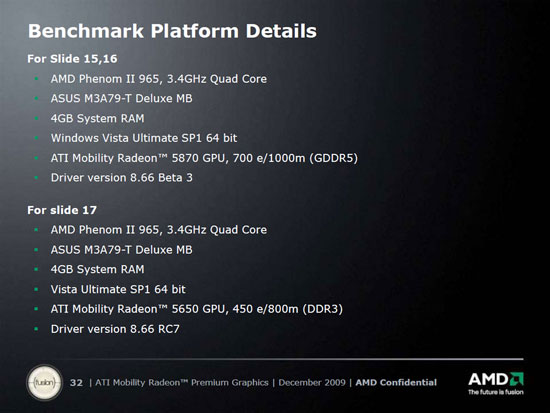
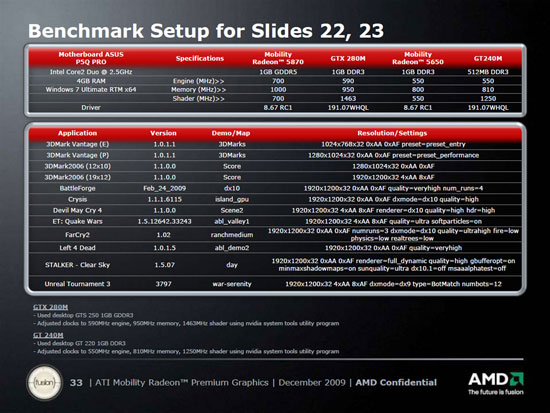
The first slide states a clock speed of 450MHz on the 5650 but the second says 550MHz. Given the figures in the ATI performance comparison, we think the 550MHz clock is correct.










32 Comments
View All Comments
Voo - Thursday, January 7, 2010 - link
"The problem is not the laptop! Yeah sure you can't do that, but I don't need that, so nobody needs it!"Great logic and it's always nice when someone tells other people what to do, because clearly he has to be right and it could not be that he just can't handle the added complexity of more monitors :p
drunkenmaster - Thursday, January 7, 2010 - link
I really would rarely sign up to a site just to post a comment, but seriously, this article felt biased from the first paragraph.Firstly as someone stated, OEM's want strict control over their laptops and want AMD to hand over drivers and let them deal with it.
Secondly you seem intent on giving the impression AMD is trying to tell us their market share is a lie, just look at the breakdown of what they sell. But you didn't highlight the fact that Nvidia's breakdown of gpu sales in the mobile area would look VERY similar, as both companies breakdowns would look in the desktop area. The biggest sales for both companies, is low end, then mid end, and high end is realistically a very small portion of their total sales. But its the way its worded, and not including Nvidia numbers, to try to intimate they haven't really been competing in high end gaming at all. Then you go on to say "but don't try to convince us that low-end discrete graphics (HD 4330 and GeForce 9300M/G110M, we're looking at you!) are anywhere near being good gaming solutions" , yes you mention an Nvidia solution but you also claimed further up that Nvidia has clearly dominated high end mobile gaming.
Hmm strange, further down the page you say high end mobile graphics are only 5% of the market, 5% of AMD's sales are high end, so logic would dictate in those magical Nvidia breakdowns you left out, that their share is only going to be 6-7% high end graphics. So wheres this domination exactly?
You also mention the reasons for this supposed, theoretical, unproven domination in the high end, the ease of changing from one core to the next, the 8800, 9800, 260/280.... you didn't seem to mention that they are all, essentially, the same core though. If AMD made a 3870, and kept making it but called it a 4870, and 5870, and 9870, it would be a pretty easy slot in upgrade also.
I just didn't like the whole feel of the article, you seem to suggest that AMD are trying to pull the wool over our eyes, AMD own 60% of the mobile market, so what, only 5% of that is gaming, Nvidia (without stating numbers) dominates here, and thats all that matters. Well, its not, 60% of the market is 60% of the market, thats kind of how life works. They sell more gpu's, infact their 5% high end sales could well be making them more profit(with smaller cores) than Nvidia's 6-7% sales in the high end, the rest of the range is almost certainly making them more profit, because they are selling more of them.
You also brought up the theoretical floppage ability of both cards, while the information isn't completely unaccurate or wrong, it just, with the tone of the rest of the piece had the same feeling, we're belittling AMD and trying to not focus on the fact that, in reality, their mobile parts are faster.
Likewise the drivers, you say you have no problem, but crossfire is iffy, well Nvidia have had two big releases, Borderlands(an Nvidia title) and Dirt 2(amd title) ship without SLI support, as did, Crysis, and several others, yes AMD have crossfire support issues, so do Nvidia. Likewise the crossfire/sli segment of high end gaming is tiny, if both companies had high end mobile cards sales of 5%, crossfire/sli would be 0.0005%. But rather than wait and see if they improve drivers which you admit work for all but a handful of crossfire uses, are there any crossfire laptops? I've not seen one, nor looked for one, I guess Alienware and a few others do, but then they probably do update their drivers, sure a company that only sells intergrated might not update drivers every 3 months, do they need to, are those guys gaming? Anyway rather than wait to see if it improves its just jumping on them.
You focus on the tiny portion you CLAIM dont' have support, but thats the general trend of the article. Dissappointed to say the least as with Anandtech I always hoped to read articles without bias, with clear facts shown from which the conclusions are drawn and well, no thats it.
I honestly don't know, maybe AMD have a bunch of crossfire laptops, so point out that Manufacturer X makes model Y and crossfire support is terrible, their forums are full of unhappy users and they can't get new drivers.
You've put together that some laptop makers don't update drivers very often, and that AMD doesn't directly support them(as you've been shown mostly at the request of the oem's), but you didn't link either of those directly to people with crossfire issues, you put one fact in a possible problem with no actual link and carried it through the article as fact.
Like I said, I could be wrong, but its your job to show it, not hint at a problem early, and take that as fact later on.
erple2 - Thursday, January 7, 2010 - link
I'm not so sure that there's as much bias as you say. Granted this article is about a press release, not a review of hardware in and of itself. Which means a significant part of the article is going to have to be necessarily conjecture.I think it was also stated in the article that OEMs wanted control over drivers. Curiously, however (as pointed out in the article), NVidia doesn't really have the same restriction - they do release drivers fairly regularly that will work with most of their mobile GPUs, which may be much to OEMs frustration.
While market share is market share, the fact is that all makers (well, the other one) makes the vast majority of their sales on the low end. In the high end, just simply looking at the design wins tells us more of the story. If AMD's high end accounts for 5% of their market share, that's 3% of the total mobile market share that's taken by AMD's high end solutions. I don't know what NVidia's share is, but if it's 4% or 5%, that's a significant increase in the "market share of high end products" owned by NVidia.
BTW, if 6-7% of the total market share of all mobile products is high end NVidia solutions, and given that we _know_ that 3% of the high end mobile market share is AMD, then clearly, NVidia has 2x+ of the market share of AMD in the high end. I'd say that's domination.
I think that _because_ the 8800, 9800, 260 and 280 are the same basic chip, OEM's have less work to do to incorporate those solutions in their products, and therefore use them more often. Since that solution is _still_ considered "high end", OEM's using those designs (as they have been for the last couple of years) have less qualification work to do, and therefore are more likely to choose those chips in their "high end" laptops. Your point, then, about if AMD simply re-packaged the 3870 into the 48xx, 58xx or "98xx" therefore solidifies the point that Jarred was making.
Ultimately, the complaints of "lack of driver support" for AMD is, in fact, partially true - NVidia has gone ahead and started incorporating unified drivers for all mobility parts. AMD has not.
As far as I can tell, there are 2 laptops available with Crossfire capability, and both of those were linked in the original article.
JarredWalton - Thursday, January 7, 2010 - link
To the OP, I understand what you're saying, but I was just trying to put everything in perspective. ATI *does* make some very good hardware, and the HD 4870 was competitive and even FASTER than GTX 280M... when it had properly working drivers. My experience in testing laptops during the past several years is that NVIDIA's current mobile driver program is far, far better than ATI's program. And you know what? NVIDIA had to deal with the same crap that ATI is dealing with, namely that big OEMs want control over their drivers.So NVIDIA started a team that makes sure each driver rollout for mobile contains all the necessary hooks for a bunch of different laptops (and granted, sometimes a driver still comes out that won't work with certain models for one reason or another). ATI is still shrugging and saying, "but this is what the OEMs want to do!" Well, screw the OEMs; what do the CUSTOMERS want ATI to do?
I said several years ago that I couldn't in good conscience recommend an NVIDIA gaming laptop until they got a better driver release program. (I believe it was a review of the Dell XPS M1710 or something similar where several new titles had issues due to old drivers.) I'm saying the same thing now for ATI. If your drivers are broken or outdated on a gaming laptop, you have for all intents and purposes a broken gaming laptop. You can't push DX11 hardware and then tell me the drivers aren't going to be broken when DX11 games start coming out.
So at the high-end, with their driver program, I'll take NVIDIA mobile GPUs in a heartbeat over ATI mobile GPUs. It's that simple. I've been burned too many times to feel otherwise. What's more, I've heard from READERS that feel exactly the same way (after buying an ATI gaming laptops). It was on the first page and I talked about it for a long time simply because it's important.
What I want is for ATI to follow NVIDIA and launch a mobile driver program where publicly available drivers are released at least quarterly. I don't care if they don't support IGP designs and every single lower-end laptop (i.e. 5400, 4500, and 4300 hardware), but if someone has a laptop with a 4600, 4800, 5600, 5700, or 5800 GPU they need to know that they'll get new drivers on a regular basis.
So tell me this: am I wrong to think that? Is it expecting too much, considering ATI's biggest competitor has done exactly that starting a couple years ago?
If all ATI has to offer at the high-end right now is 25% better performance than GTX 280M, I'd either wait to hear about ATI's new mobile driver program, wait to see what NVIDIA's next hardware will be, or just get an NVIDIA solution.
Bias? Perhaps, but it's exactly what I would recommend right now for gaming laptops. NVIDIA may not have functioning SLI support on every new game that ships, but at least you know there's a good chance they will have it within the next three months. Ask ASUS W90 owners how the CrossFire support is working if you want the other side of the story.
Finally, I'm just going to throw this out there: hacking drivers to make them install was possible with NVIDIA as well as ATI solutions. The problem is, optimizations are not all present in many cases. Every time I've used hacked drivers, my performance has dropped in most titles. It might fix one broken game that's a recent release, but it usually comes with 5% to 15% (sometimes more) performance drops elsewhere. I don't want to have to swap drivers every time I play a different game, and I don't think anyone else does either. Just because it's possible doesn't mean it's ideal or without problems. When I get another ATI laptop, maybe I'll try it just to see how performance works... right now, the only ATI hardware I have is an HD 3200, so drivers aren't going to make a real difference.
rjc - Sunday, January 10, 2010 - link
From here AMD Driver improvements coming over next few months:http://www.behardware.com/news/10636/catalyst-inno...">http://www.behardware.com/news/10636/catalyst-inno...
- CrossFire X profiles per application will now be in a separate XML file that it will be possible to update independently of the driver itself
...
- If laptop manufacturers allow it, possibility of installing the Catalysts on a laptop in Vista and 7
....
Nvidia has the 3xx series of mobile parts but these are the same chips as previously sold under the 2xx banner maybe with a slightly increased clocks. Nvidia is working on Fermi derivative chips but they are not expected at best before the second half of the year
Finally here is a pcper article on nvidia making drivers available for laptops: http://www.pcper.com/comments.php?nid=6565">http://www.pcper.com/comments.php?nid=6565
...it is dated Dec 18 2008, not nearly 2 years ago.
Rereading the above I sound like an apologist for ATI :( If you want to criticise the company the 4550 and 4670 renamed as 5 series parts would be a better target. Perhaps also not giving you any notebooks to test for the article - that's not very professional.
JarredWalton - Tuesday, January 12, 2010 - link
I suppose "discussed" and "launched" are the difference with NVIDIA. I first heard about the mobile driver program at the end of 2007, and I first talked about it http://www.anandtech.com/mobile/showdoc.aspx?i=327...">with the Gateway P-6831 FX. The first drivers to come out were round about the end of 2008, though, which makes me wonder how soon ATI can announce and then release drivers for their mobile driver program. Here's to hoping they do it faster/better than NVIDIA.Sbijman - Thursday, January 7, 2010 - link
"We have no concerns about ATI's ability to do so on the desktop, but right now they don't have any mobile driver plan as far as we can tell, referring you instead to your notebook manufacturer."There is a (not very official?) ATI mobile driver program, but it's OEMs that are messing it up. According to [url=http://www.hardwareheaven.com/modtool.php">http://www.hardwareheaven.com/modtool.php]Hardwareheaven[/url] they request ATI to not support the graphics boards in their laptops so they can manage their own drivers.
There is a way around it, which is to hack the bit of the driver that identifies your hardware, and enable it to install even though it doesn't officially that specific laptop. Hardwarehaven has a tool for this.
Sbijman - Thursday, January 7, 2010 - link
Can't find the edit button :SThe tool is available at http://www.hardwareheaven.com/modtool.php">http://www.hardwareheaven.com/modtool.php
Hauk - Thursday, January 7, 2010 - link
Man I just bought an i7/4670 laptop. Can these boards be had and swapped?SlyNine - Thursday, January 7, 2010 - link
I have the same question, I wish they would do a review on the Dell 1645(XPS 16 studio which is what I'm guessing you got as well) w/ I7 and 4670 1 gig.I'd really like to know how that performs in comparison to other notebooks.